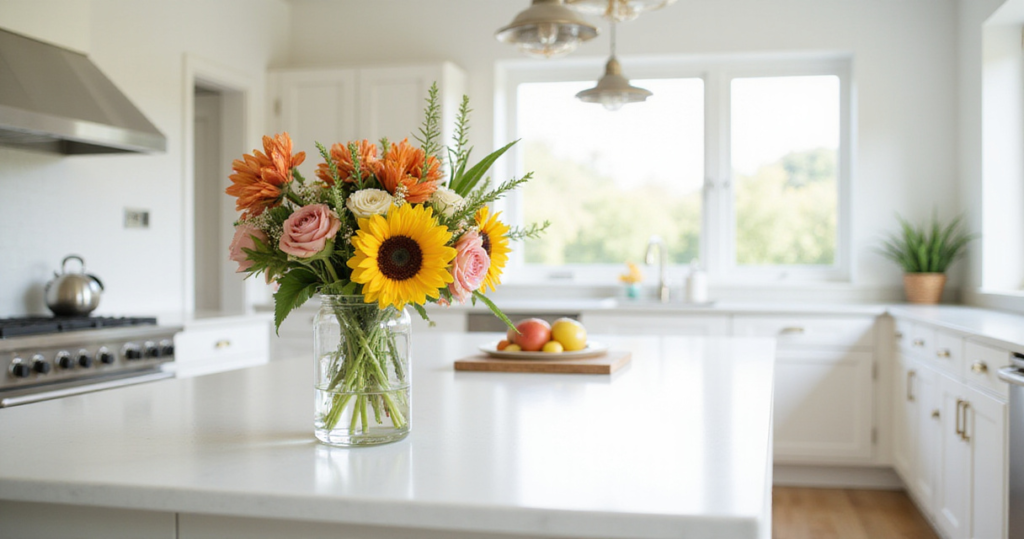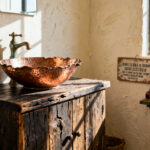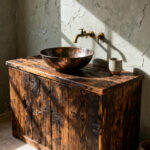The kitchen island stands as the unsung hero of our cooking spaces – a central hub where culinary magic happens, conversations flow, and memories form. In historic homes, these islands often represent a beautiful marriage between original architecture and modern functionality. As someone who’s spent years helping homeowners honor their home’s heritage while adapting spaces for contemporary living, I’ve found that kitchen island decorating offers a perfect opportunity to blend period-appropriate charm with practical everyday use.
Each decorative element you choose tells a story – much like the exposed beams or original millwork in your historic home. The right kitchen island decorating approach transforms this functional workspace into a visual anchor that complements your home’s character while meeting your family’s daily needs.
1. Add a Fresh Floral Arrangement or Greenery
Nothing breathes life into a historic kitchen quite like natural elements. When selecting greenery for kitchen island decorating, consider both the light conditions and the architectural period of your home. Victorian-era homes often featured elaborate floral displays, while Craftsman bungalows embraced simpler, more structured arrangements.
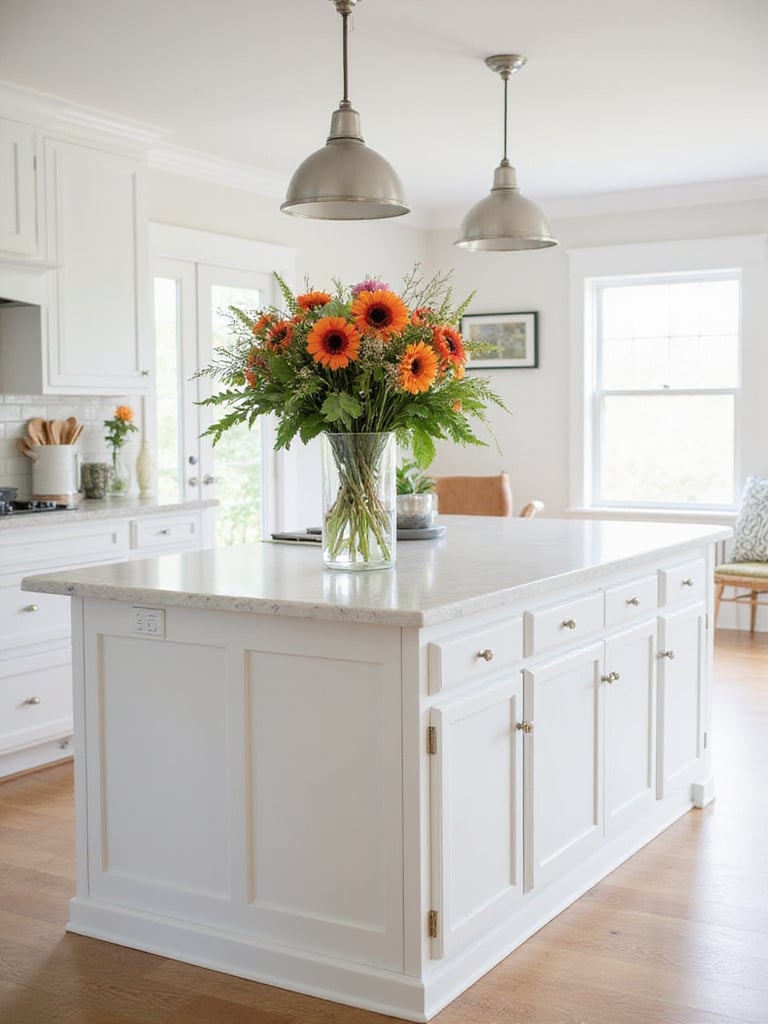
Low-maintenance options like pothos, snake plants, or herbs in period-appropriate containers work beautifully. For historic homes with limited natural light, consider cyclamens or peace lilies that thrive in indirect light. The container itself matters tremendously – look for pottery, copper, or ceramic vessels that complement your home’s era, whether it’s a simple earthenware crock for a farmhouse kitchen or a more ornate container for a Victorian space.
The inspiration for this collection struck when I visited a 1910 Craftsman home where the owners had placed a simple arrangement of native ferns in a handcrafted pottery bowl, creating a perfect bridge between the home’s Arts and Crafts heritage and modern functionality.
2. Display a Beautiful Fruit Bowl or Decorative Bowl
A bowl, whether filled with seasonal produce or standing empty as a sculptural element, has been a kitchen staple for centuries. In historic kitchen island decorating, bowls serve as functional art that connects past and present.
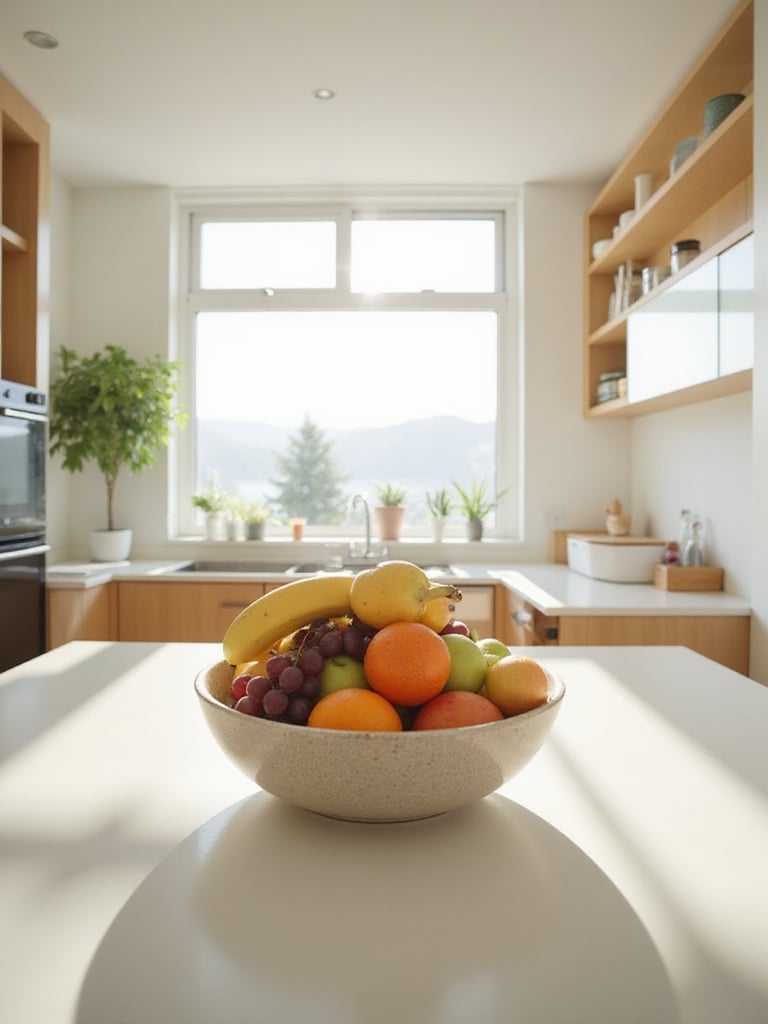
For period authenticity, consider materials common to your home’s era – hand-thrown pottery for Colonial or early American homes, pressed glass for Victorian kitchens, or hammered copper for Arts and Crafts spaces. The contents matter too – apples, pears and citrus have adorned kitchens for generations, while decorative bowls might showcase collections of vintage kitchen tools, antique spools, or other items that reflect your home’s history.
“In my restoration work, I’ve found that the most successful historic kitchens balance preservation with practicality. A beautiful bowl on the island bridges that gap perfectly, honoring traditional forms while serving modern needs.” – Mark Anderson
Unlike conventional options, this approach reduces the need for purely decorative items while maintaining historical integrity through functional pieces that would have been familiar to your home’s original owners.
3. Incorporate a Stylish Tray to Corral Items
Trays have been kitchen workhorses for centuries, evolving from simple wooden boards to elaborate silver serving pieces. Using a tray on your island creates a designated zone that prevents scattered items while adding a layer of intentional design to your kitchen island decorating.

Select trays that reference your home’s architectural period – hammered tin for Colonial, silver-plate for Victorian, or quarter-sawn oak for Craftsman homes. Group items that make visual and practical sense together: perhaps vintage salt and pepper cellars alongside a small butter dish, or a collection of period-appropriate serving pieces. The tray itself becomes both boundary and backdrop, containing visual clutter while showcasing cherished items.
Beyond the obvious placement, consider using this for creating seasonal displays that honor your home’s history – perhaps showcasing antique cookie cutters during holidays or vintage seed packets in spring, all contained neatly on a tray that complements your kitchen’s architectural heritage.
4. Showcase a High-Quality Cutting Board
A cutting board might seem utilitarian, but in historic kitchen island decorating, it represents the perfect marriage of beauty and function. The cutting board has evolved alongside domestic architecture, from simple slabs to carefully crafted kitchen tools.
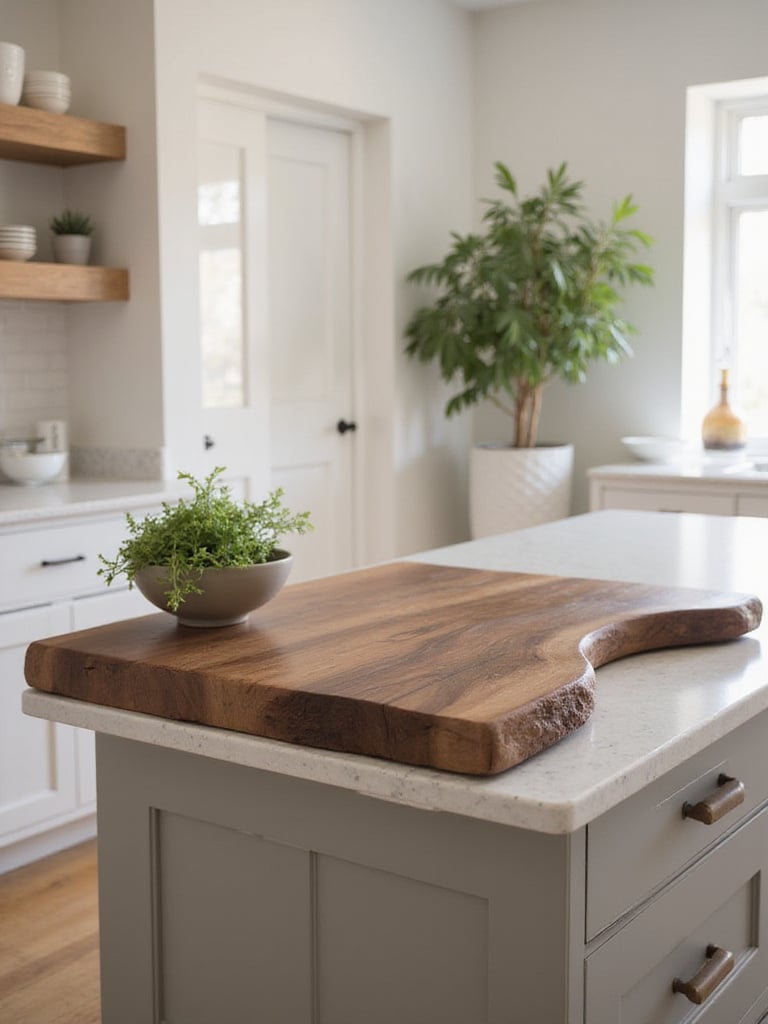
For period-appropriate styling, consider materials that would have been used in your home’s era. End-grain maple or walnut boards suit most historical periods, while olive wood might complement Mediterranean Revival homes. Live-edge boards work beautifully in Craftsman or rustic farmhouse kitchens. Position your board where it makes practical sense – perhaps angled slightly against a backsplash or propped against another decorative element to add height variation.
The craftsmanship reveals itself in details like the joinery techniques used in high-quality boards, which often mirror the woodworking found in historic homes. This connection between your kitchen island decorating and the home’s architectural woodwork creates subtle visual harmony throughout the space.
5. Stack a Few Favorite Cookbooks
Cookbooks tell the story of domestic life through the ages, making them perfect additions to kitchen island decorating in historic homes. A thoughtfully arranged stack adds color, texture, and personality while celebrating culinary traditions.
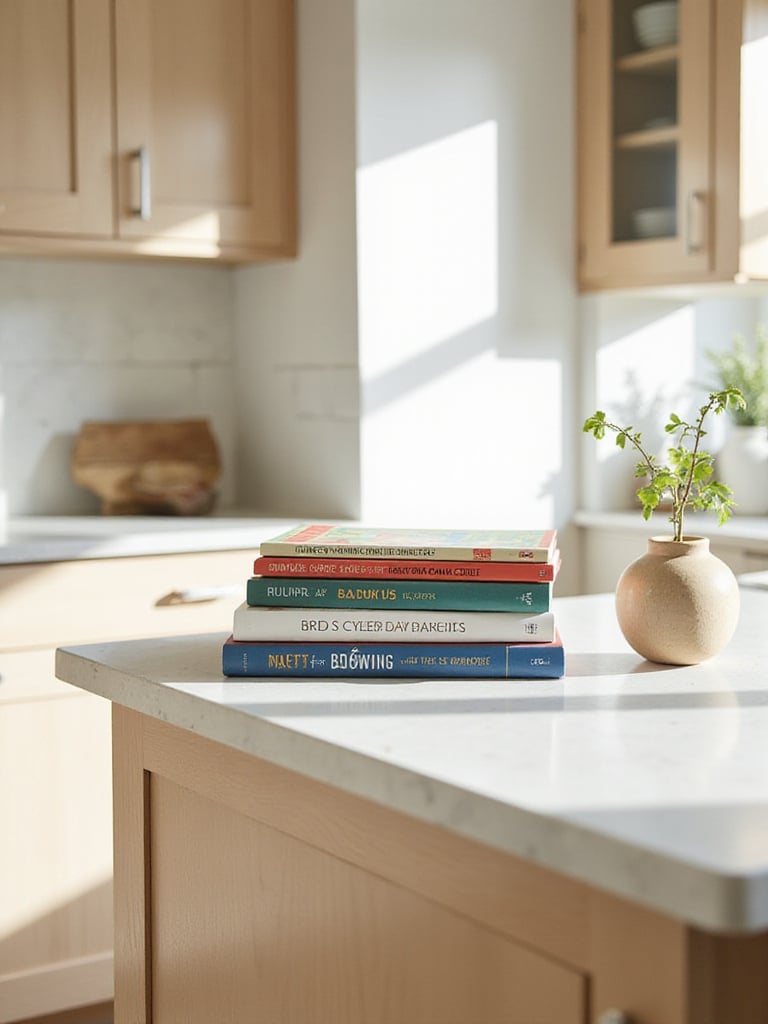
For authentic period styling, consider including at least one cookbook from your home’s original era – perhaps a reprint of “The Boston Cooking-School Cook Book” for a Victorian home or “The Settlement Cook Book” for an early 20th-century kitchen. Balance these historical references with modern volumes whose design complements your kitchen’s aesthetic. Arrange them thoughtfully, perhaps with the largest at the bottom and smaller ones offset slightly above, or with bookends that reference architectural elements from your home.
The unexpected pairing that always works is combining a historically significant cookbook with contemporary volumes that share similar binding styles or color palettes, creating a bridge between your home’s past and your family’s present culinary adventures.
6. Place Decorative Candles or a Diffuser for Scent
Before electricity illuminated our homes, candles provided essential light in kitchens across architectural periods. Incorporating them into your kitchen island decorating honors this heritage while adding warmth and ambiance to the space.
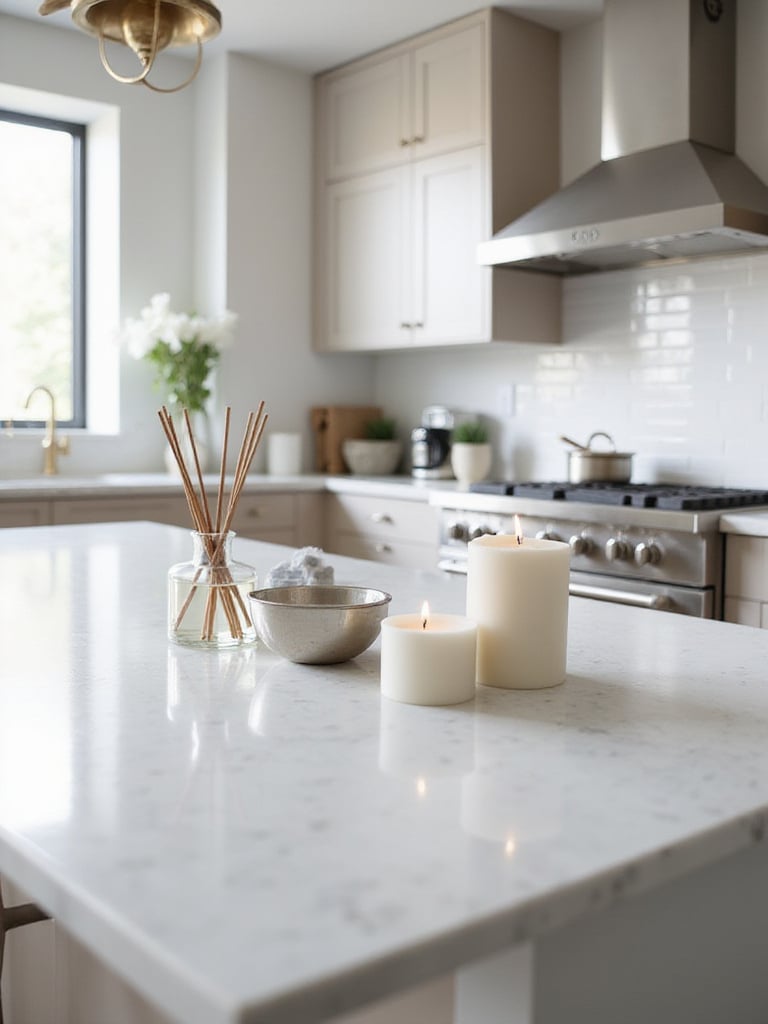
Choose candle styles that reference your home’s era – simple beeswax tapers for Colonial or Federal homes, more elaborate candlesticks for Victorian spaces, or craftsman-inspired lanterns for bungalows. For safety in busy kitchens, consider battery-operated flameless candles in authentic holders. Scent choices matter too – citrus and herb scents like rosemary, lavender, or lemon work well in most historic kitchens, while avoiding overly modern or synthetic fragrances that would feel out of place.
The environmental story behind this piece began centuries ago when households relied on natural materials for both light and fragrance. By incorporating these elements thoughtfully into your kitchen island decorating, you create a sensory connection to your home’s original character.
7. Introduce Texture with Folded Tea Towels or Linens
Textiles have always softened the hard surfaces of kitchens, and incorporating them into your kitchen island decorating adds authentic period texture while serving practical needs. The simple tea towel has a rich history in domestic architecture, evolving alongside kitchen design.
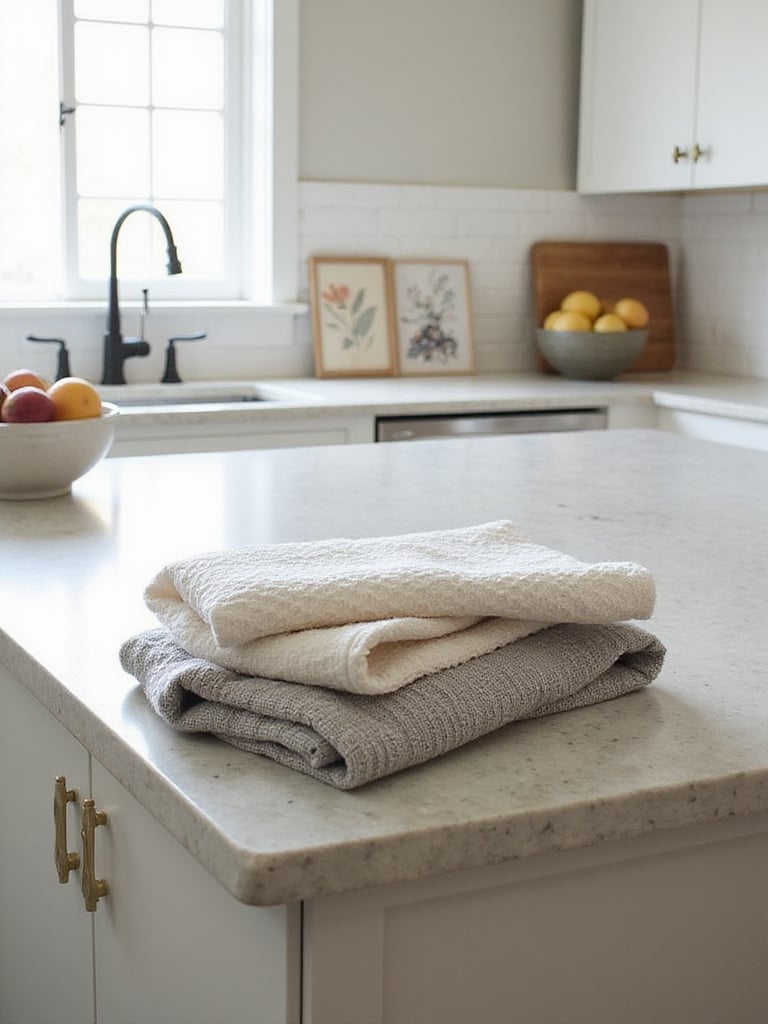
For historically accurate styling, look for materials and patterns appropriate to your home’s era – simple linen for Colonial kitchens, embroidered cotton for Victorian spaces, or hand-blocked prints for Arts and Crafts homes. Display them thoughtfully, perhaps rolled in a period-appropriate basket, folded neatly on a corner of the island, or draped casually over a nearby hook or rail. The key is ensuring they look intentional rather than haphazard.
- Hand-loomed linens add authentic texture to Federal and Colonial kitchens
- Damask or jacquard patterns suit Victorian and Edwardian spaces
- Simple stripes or geometric patterns complement Craftsman and mid-century homes
- Natural fibers like linen, cotton, and hemp maintain historical accuracy across periods
If you’ve struggled with similar rooms before, incorporating textiles might be the missing element that brings warmth to your kitchen island decorating while honoring traditional materials and techniques.
8. Select Eye-Catching Pendant Lights Above the Island
The evolution of kitchen lighting tells a fascinating architectural story, from candles to gas fixtures to early electric pendants. When selecting lighting for kitchen island decorating in historic homes, balancing period authenticity with modern functionality becomes crucial.
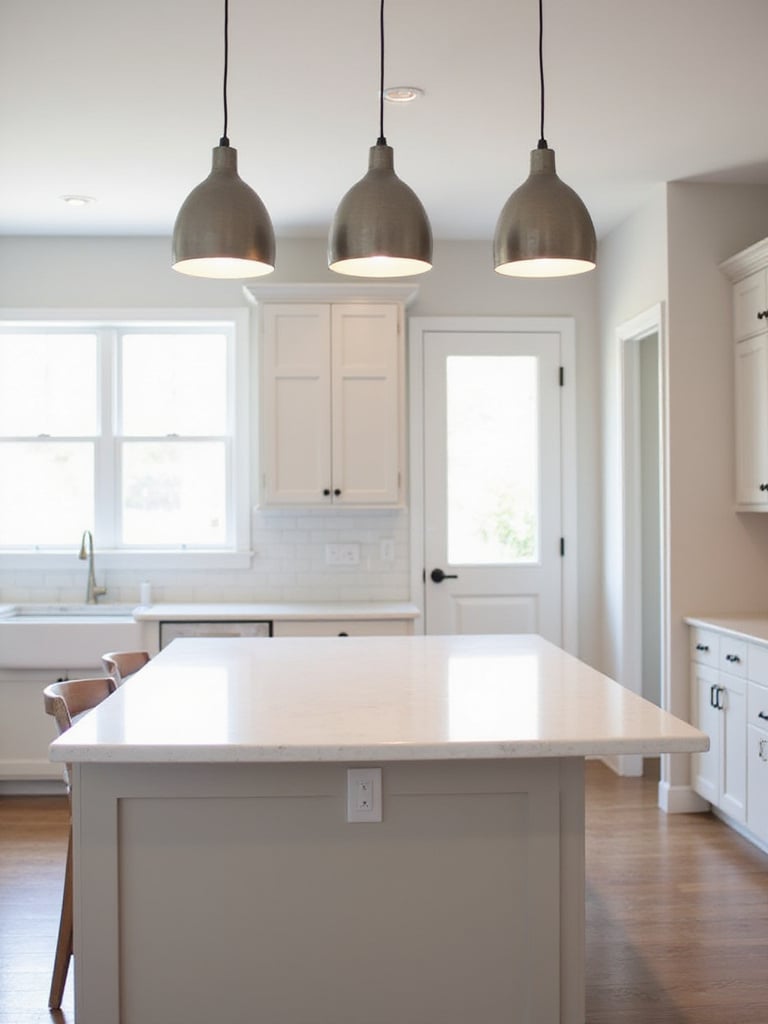
Choose fixtures that reference your home’s era without slavishly reproducing it – perhaps schoolhouse pendants for a 1920s bungalow, simplified Victorian-inspired fixtures for Queen Anne homes, or streamlined dome pendants for mid-century kitchens. The scale matters tremendously – for islands under 6 feet, two pendants generally work well, while longer islands might require three or more to provide balanced illumination. Hang them approximately 30-36 inches above the countertop to provide adequate task lighting without obstructing sightlines.
The artisan collective that creates these pieces often specializes in adapting historical lighting designs for modern electrical systems, allowing your kitchen island decorating to honor traditional forms while meeting contemporary safety standards and lighting needs.
9. Choose Stylish and Comfortable Counter Stools
Seating around kitchen islands has evolved alongside domestic architecture, from simple wooden stools to more elaborate designs. Selecting the right seating is essential for both comfort and historical accuracy in your kitchen island decorating approach.
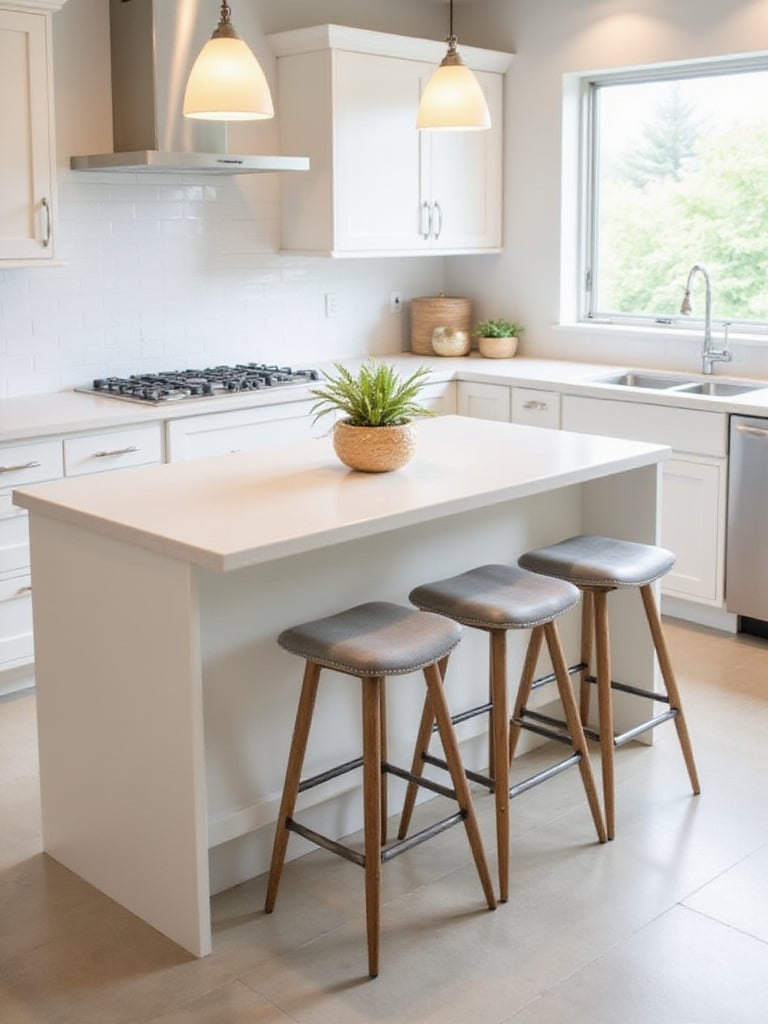
For authentic period styling, research seating types common during your home’s era – Windsor-inspired stools might suit Colonial Revival kitchens, while bentwood designs complement Victorian spaces and simple slatted backs work well in Craftsman homes. Measure carefully for proper height – typically 24-26 inches for counter-height islands around 36 inches tall. The space between stools matters too; allow 24-30 inches between centers for comfortable seating without crowding.
The maker’s journey from apprentice to master influenced many traditional stool designs, with construction techniques that mirror the craftsmanship found throughout historic homes. By selecting seating that references these traditions, your kitchen island decorating creates coherence between architectural elements and furnishings.
10. Add a Small Sculpture or Decorative Object
Introducing a single, well-chosen decorative object to your kitchen island creates a focal point that reflects your home’s character while personalizing the space. Historic kitchens often featured decorative elements that told stories about the home’s inhabitants.
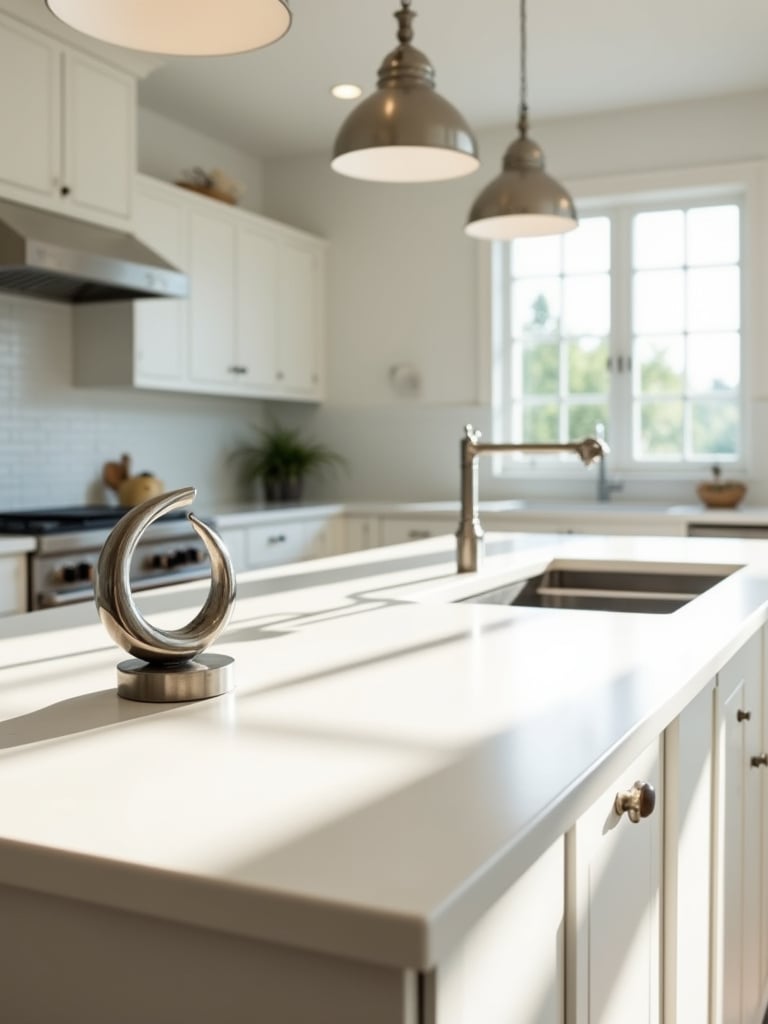
Select pieces that would feel at home in your kitchen’s original era – perhaps a small bronze figure for Victorian spaces, a handcrafted ceramic piece for Arts and Crafts homes, or a turned wooden object for Colonial kitchens. The scale should be appropriate to your island size; a large island can support a more substantial piece, while smaller islands benefit from more modest objects. Position it thoughtfully, perhaps offset from center or grouped with complementary items of varying heights.
The silhouette draws inspiration from architectural elements found throughout your historic home, creating subtle connections between your kitchen island decorating and the building’s original character while adding a layer of personal expression.
11. Use Chic Canisters for Storage or Display
Storage containers have evolved alongside kitchen design, from early crocks and tins to specialized canisters for various ingredients. Incorporating these functional pieces into your kitchen island decorating honors historical food storage traditions while adding visual interest.
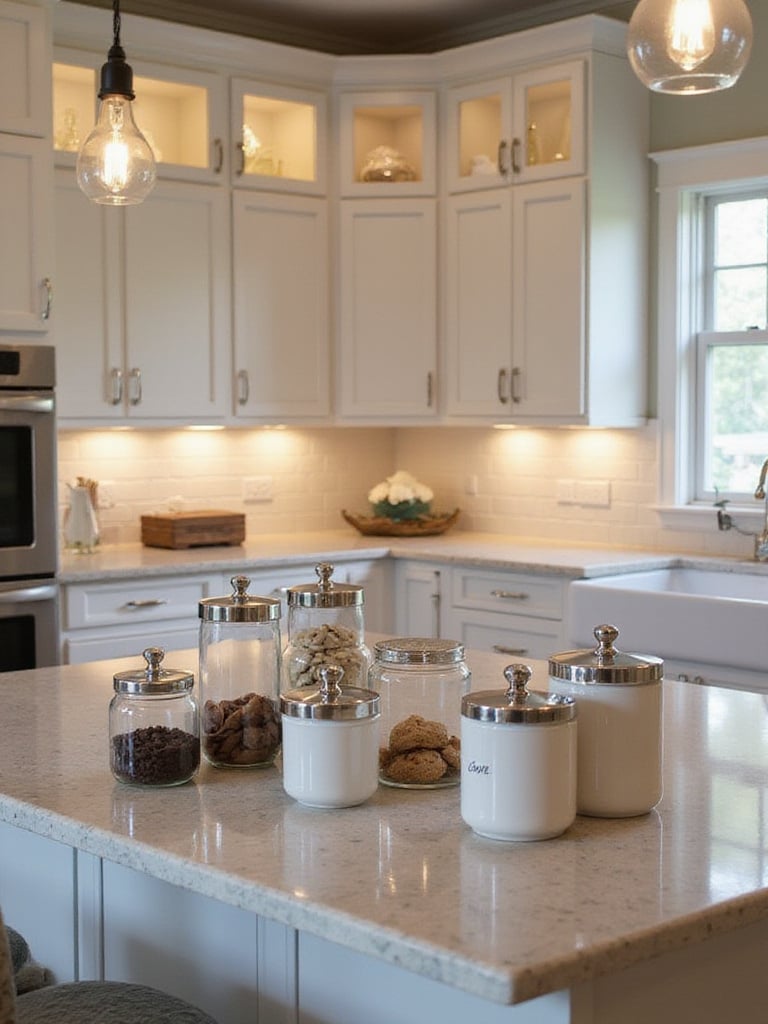
Choose materials and styles authentic to your home’s period – perhaps stoneware crocks for Federal or Colonial homes, glass canisters with metal lids for Victorian kitchens, or ceramic containers with simple glazes for Craftsman spaces. Group them thoughtfully rather than in rigid rows, varying heights and creating natural clusters. Contents matter too – storing items you use regularly ensures these pieces earn their place through both beauty and function.
The traditional methods used result in storage pieces that connect your kitchen to domestic traditions spanning generations. This approach to kitchen island decorating celebrates the evolution of home kitchens while meeting contemporary needs for accessible ingredients and cooking tools.
12. Showcase a Stylish Small Appliance (e.g., Kettle, Mixer)
While modern appliances weren’t part of historic kitchens, thoughtfully selected pieces can bridge past and present in your kitchen island decorating. Many manufacturers now offer designs that reference traditional forms while providing contemporary function.
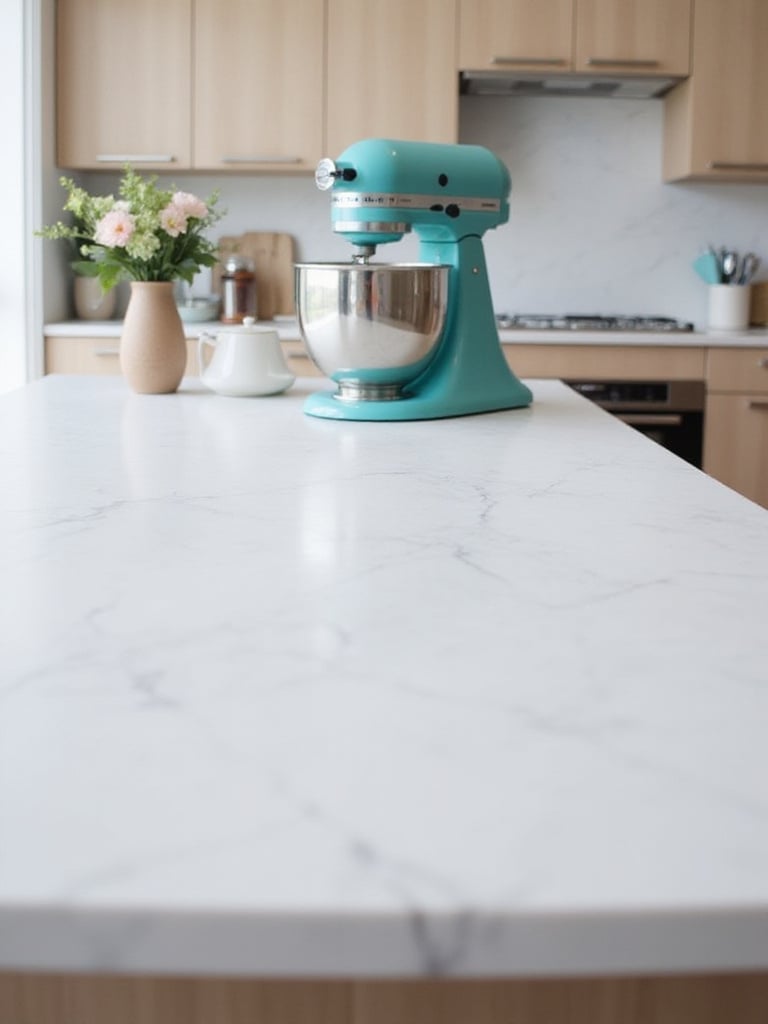
Look for appliances with retro styling appropriate to your home’s era – perhaps a kettle with Victorian-inspired curves, a stand mixer in a heritage color, or a toaster with Art Deco lines. Position these pieces intentionally, perhaps on a trivet or small tray that complements your kitchen’s materials. The goal is integration rather than intrusion – these modern necessities should feel like natural extensions of your historic kitchen’s evolution.
After months of sourcing and curation, I’ve found that the most successful kitchen island decorating in historic homes acknowledges that kitchens have always evolved to incorporate new technologies, allowing carefully selected modern appliances to coexist with traditional elements.
13. Incorporate Seasonal Decor for a Fresh Look
Seasonal decorating has deep roots in domestic architecture, with kitchens historically showcasing nature’s bounty throughout the year. Adapting your kitchen island decorating to reflect changing seasons connects your home to traditional rhythms while keeping the space feeling fresh.
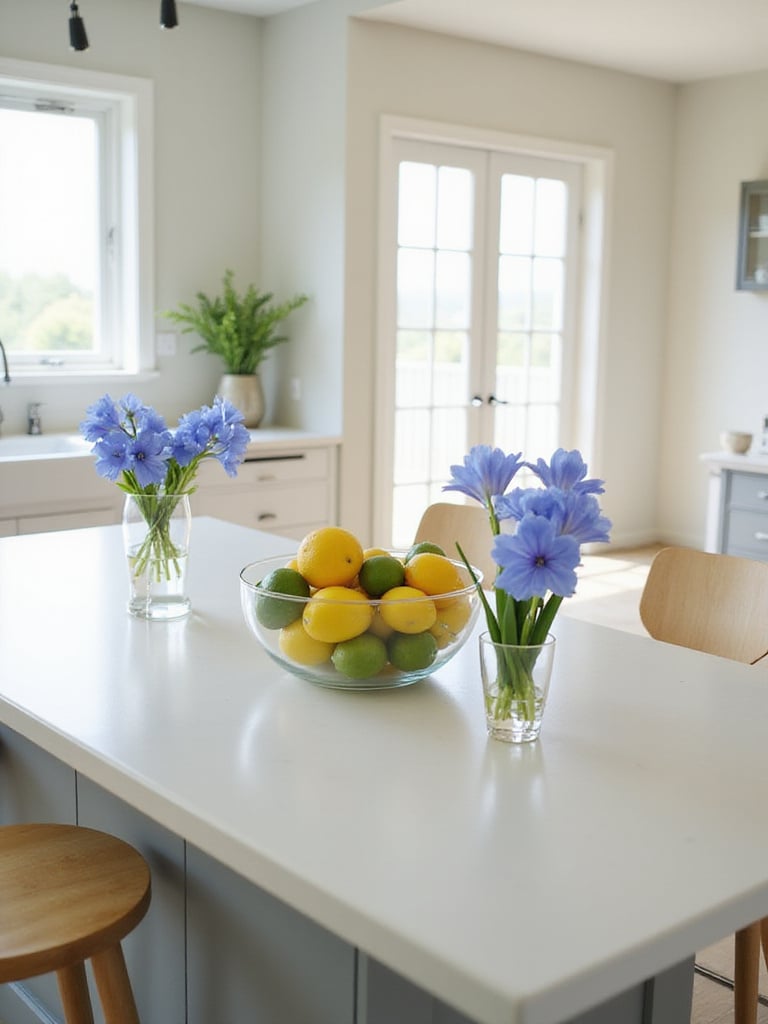
For historically accurate seasonal displays, research what would have been available during your home’s era – perhaps forcing bulbs in winter for Victorian kitchens, displaying harvest vegetables in fall for farmhouse spaces, or showcasing native wildflowers in spring for Craftsman homes. Keep these displays proportional to your island size and appropriate to a food preparation area, focusing on natural materials and avoiding synthetic decorations that would feel out of place in a historic kitchen.
This season’s palette emerged from traditional practices of bringing outdoor elements inside, creating kitchen island decorating that changes naturally with the calendar while maintaining period-appropriate styling throughout the year.
14. Display Functional Decor Like Nice Salt & Pepper Grinders
Essential cooking tools have always found homes on kitchen work surfaces, evolving in form while maintaining their function. Incorporating well-designed salt and pepper grinders into your kitchen island decorating honors this tradition of beautiful utility.
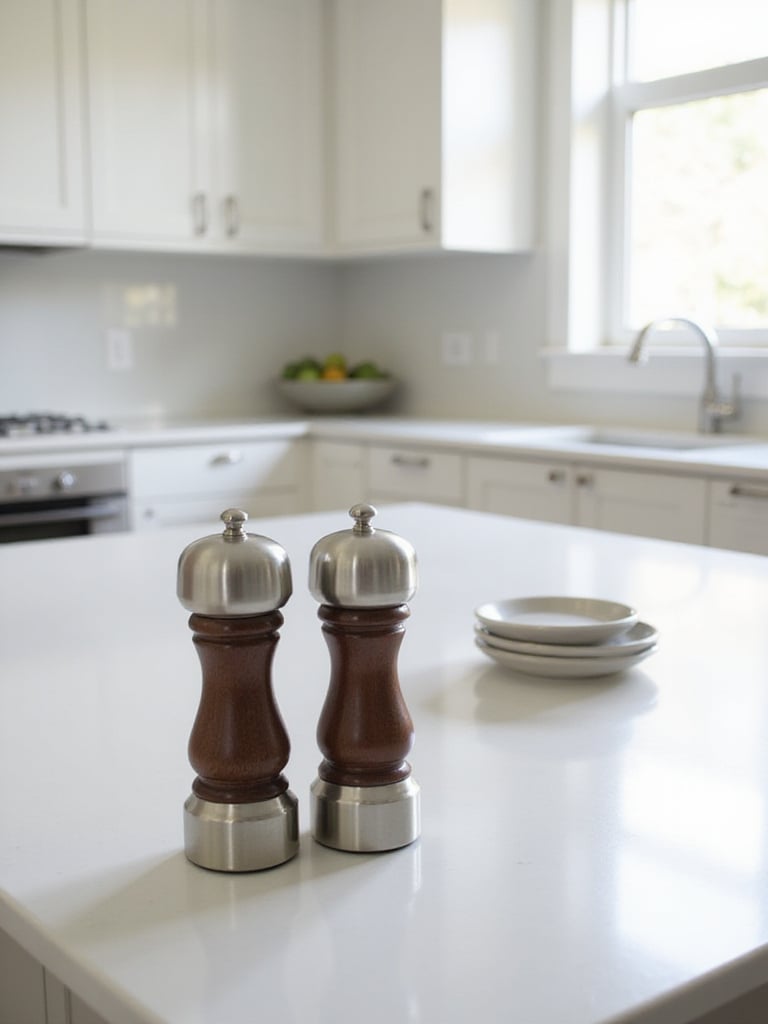
Select grinders with materials and forms that complement your home’s architectural period – perhaps wooden mills for Colonial or Craftsman kitchens, marble and brass for Victorian spaces, or ceramic for mid-century homes. Position them thoughtfully, perhaps on a small tray or trivet that protects your countertop while creating a deliberate grouping. Their regular use justifies their prominent placement, making them perfect examples of functional decoration.
What separates artisanal quality from mass-produced is the attention to both form and function, creating kitchen tools that work beautifully while enhancing your kitchen island decorating through authentic materials and craftsmanship.
15. Create Visual Interest with Varying Heights
The principle of varying heights in display has roots in traditional interior arrangement across architectural periods. Applying this timeless approach to kitchen island decorating creates visual rhythm and interest while making the space feel intentionally designed.
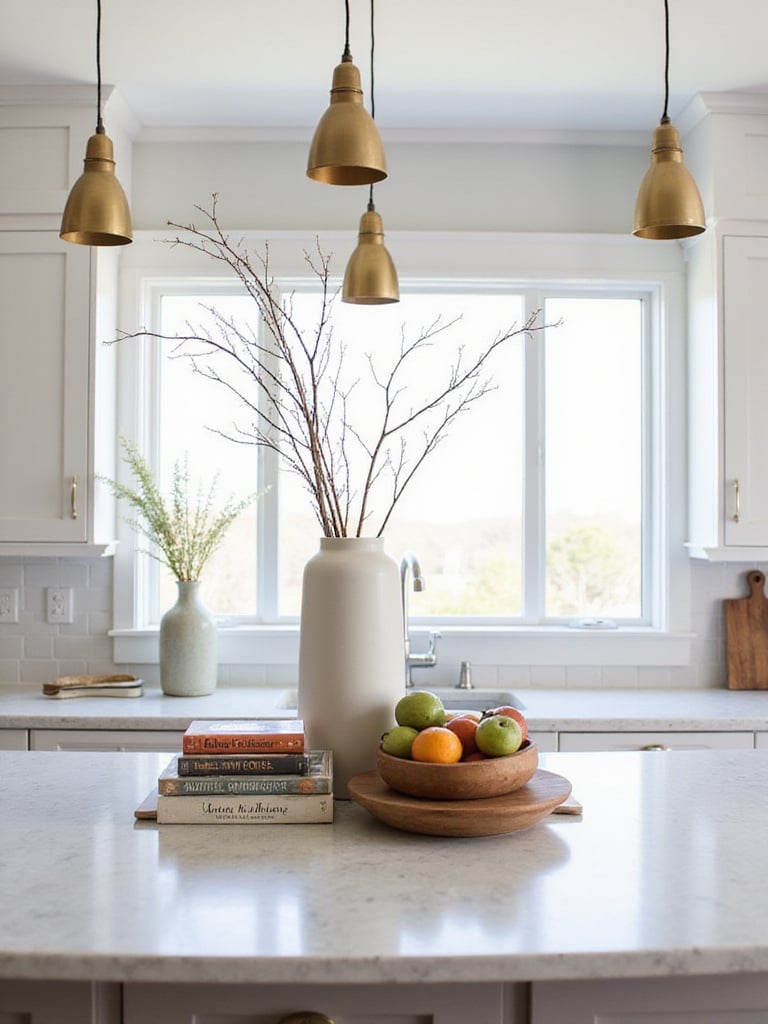
Combine items of different heights in ways that would feel natural in your home’s original era – perhaps a tall candlestick or pitcher alongside medium-height canisters and lower bowls or boards. Create triangular arrangements rather than straight lines, with taller items typically positioned toward the back or center of groupings. This variation prevents your island from feeling flat or static while referencing traditional display techniques appropriate to your home’s period.
Look closely and you’ll notice the subtle texture of these height relationships creating visual pathways across your kitchen island, guiding the eye naturally through your carefully considered kitchen island decorating approach.
16. Mix Materials and Textures in Your Decor
Historic kitchens naturally incorporated diverse materials – wood, metal, ceramic, glass, and textiles – creating rich textural landscapes. Embracing this material diversity in your kitchen island decorating adds authentic depth while creating visual interest.
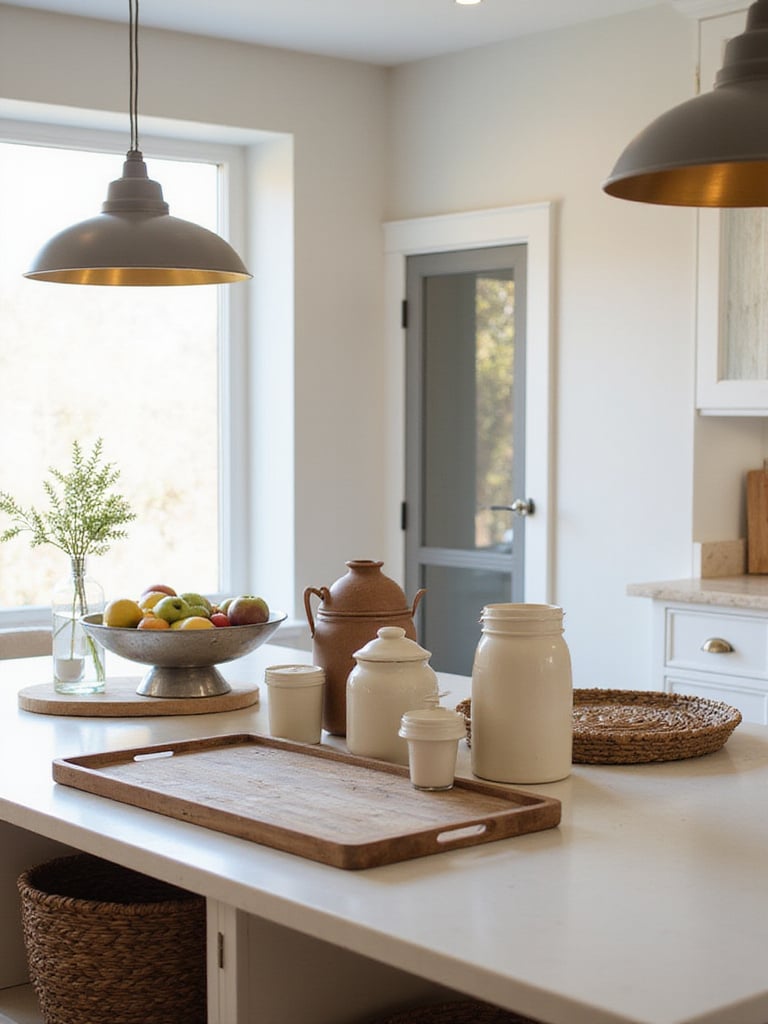
Combine materials in ways that would have occurred naturally in your home’s original kitchen – perhaps wooden boards alongside ceramic crocks, metal utensil holders, and glass canisters, all united by a common color palette or design sensibility. Ensure these combinations feel harmonious rather than chaotic by limiting your palette to 3-4 materials that complement your kitchen’s existing finishes. The juxtaposition of smooth and rough, shiny and matte creates subtle visual tension that makes your island more engaging.
The craftsmanship in this collection tells a story of traditional kitchen materials coming together in harmony, creating kitchen island decorating that honors historical material relationships while feeling fresh and intentional.
17. Keep One Area Intentionally Clutter-Free
Work surfaces have always been precious in kitchens across architectural periods, with efficient households maintaining clear areas for food preparation. Preserving open space in your kitchen island decorating acknowledges this practical tradition while creating visual breathing room.
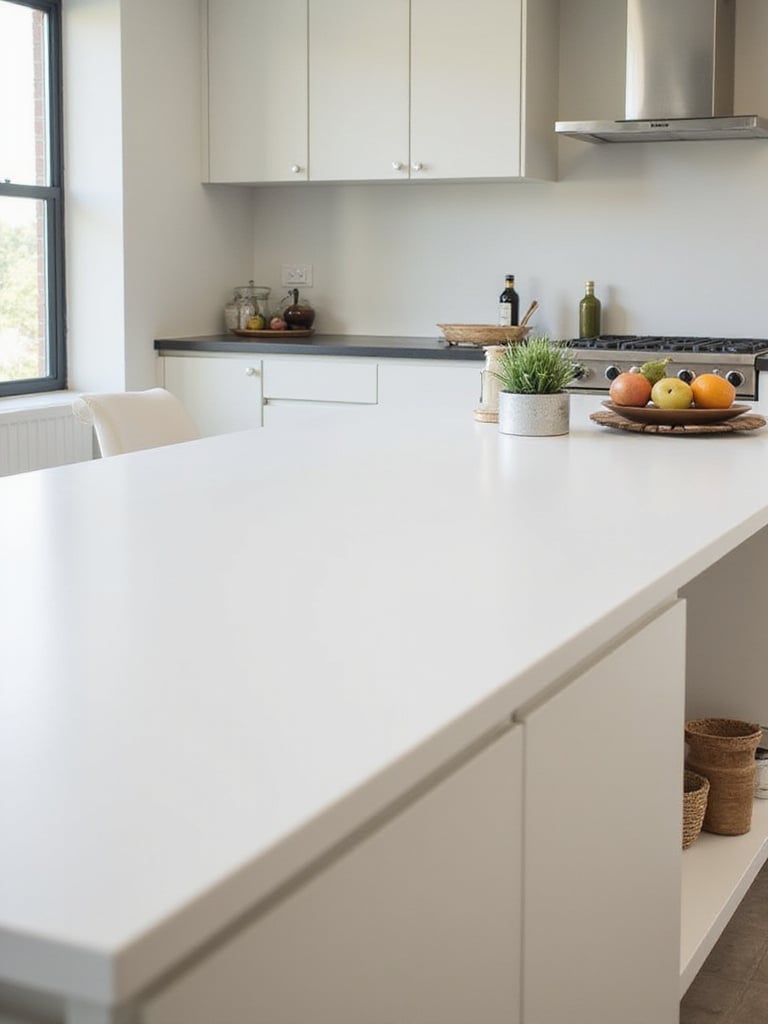
Designate a section of your island – ideally at least 24-36 inches wide – that remains consistently clear for food preparation, serving, or other activities. This intentional negative space enhances the decorative elements you’ve chosen for other areas while maintaining the island’s fundamental functionality. In historic kitchens, work areas were kept meticulously clear when not in active use, a practice worth preserving in contemporary kitchen island decorating.
Even in smaller spaces, here’s how this works: the clear area provides visual relief that actually enhances your decorative elements, creating a more balanced and authentic approach to kitchen island decorating that honors both form and function.
18. Include a Personal Item or Keepsake
Historic kitchens often contained personal touches that reflected the home’s inhabitants – family heirlooms, treasured gifts, or meaningful collections. Incorporating similar elements into your kitchen island decorating connects your space to this tradition of personalization.
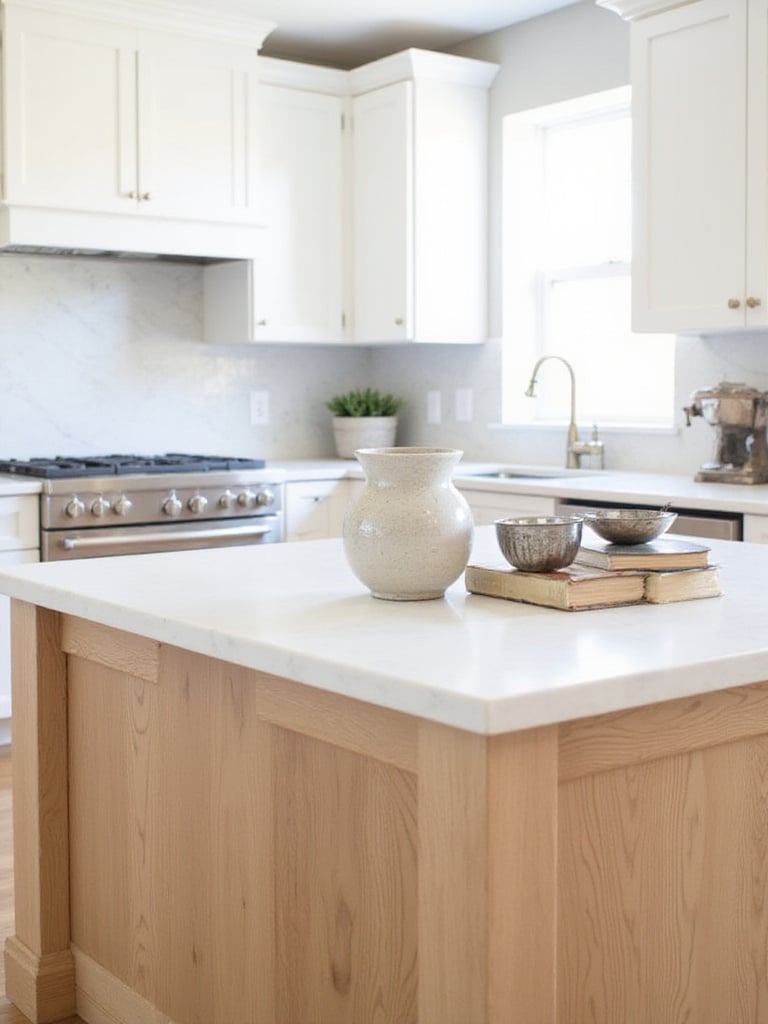
Choose items with significance that complement your home’s period – perhaps a vintage kitchen tool passed down through generations, a special piece of pottery from your travels, or a small framed recipe in your grandmother’s handwriting. Position these treasures thoughtfully, perhaps elevated on a small stand or tray to signal their importance. These personal elements transform generic kitchen island decorating into a meaningful expression of your connection to both past and present.
The cultural heritage preserved in each piece includes not just the object itself but the stories it carries, creating kitchen island decorating that resonates with personal history while honoring your home’s architectural legacy.
19. Define Zones if Your Island is Large
Large kitchen islands are modern interpretations of traditional work tables that often served multiple functions in historic kitchens. Defining distinct zones in your kitchen island decorating acknowledges this functional heritage while improving organization and workflow.
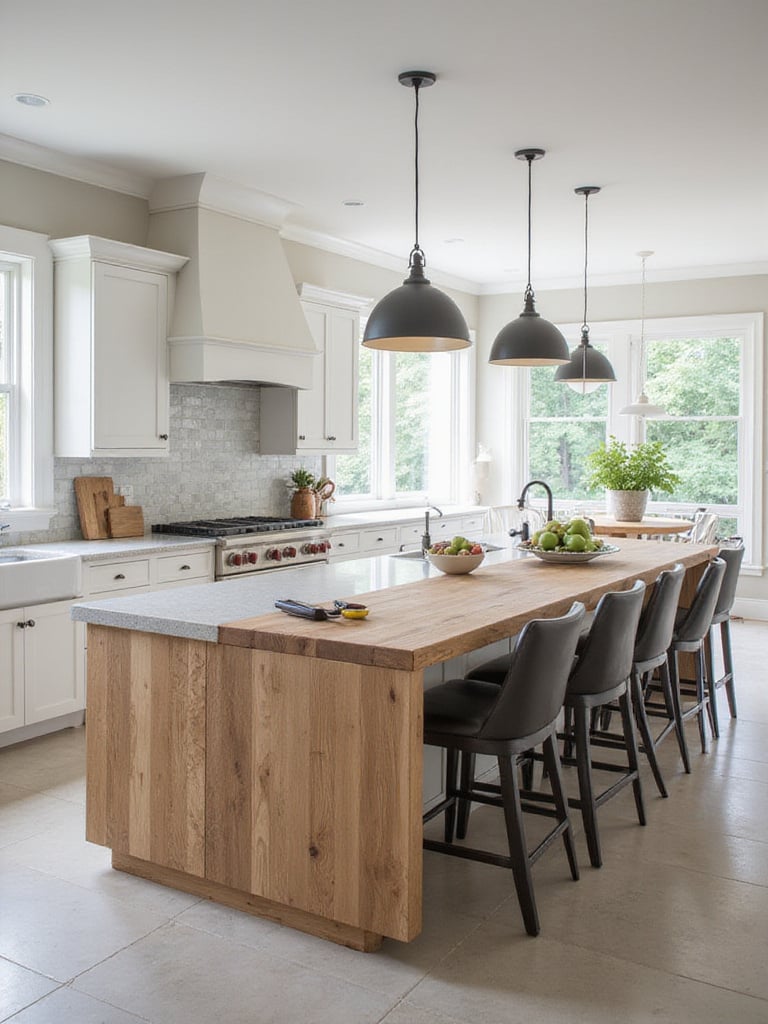
Create natural divisions that would make sense in your home’s original era – perhaps a preparation area with cutting boards and tools, a serving section with platters or trays, and a decorative zone with more ornamental elements. These divisions can be subtle, defined by groupings of items rather than physical barriers. Consider how traffic flows around your island and position zones accordingly, with frequently used areas easily accessible from primary work paths.
We’ve been working behind the scenes on something special – a zoned approach to kitchen island decorating that honors historical kitchen organization while accommodating contemporary family needs, creating spaces that function beautifully while respecting architectural heritage.
Conclusion
Kitchen island decorating in historic homes offers a unique opportunity to honor architectural traditions while creating spaces that serve modern families beautifully. By selecting elements that reference your home’s original era – whether through materials, forms, or arrangements – you create a kitchen that feels authentic rather than contrived.
Remember that historic kitchens were working spaces that evolved constantly to incorporate new technologies and techniques. Your thoughtfully decorated island continues this tradition, balancing preservation with practicality and creating a space where your family can write the next chapter of your home’s ongoing story. The most successful kitchen island decorating doesn’t freeze your space in time but rather acknowledges its past while embracing its present and future.
